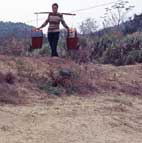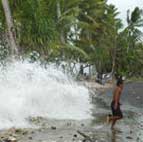 Polar bears threatened by thaw across the Arctic |  Ecosystems shift up mountainsides | ||
 China, rousing giant of global warming |  Ocean inundates island nations |
The report's key information has been well reported here and in Earth Under Fire and other books, but bears repeating in its straightforward language and up-to-date numbers.
Human activities have led to large increases in heat-trapping gases over the past century. The global warming of the past 50 years is due primarily to this human-induced increase. Global average temperature and sea level have increased, and precipitation patterns have changed.
Human “fingerprints” also have been identified in many other aspects of the climate system, including changes in ocean heat content, precipitation, atmospheric moisture, plant and animal health and location, and Arctic sea ice.
In the U.S., the amount of rain falling in the heaviest downpours has increased approximately 20 percent on average in the past century.
Many types of extreme weather events, such as heat waves and regional droughts, have become more frequent and intense during the past 40 to 50 years. The destructive energy of Atlantic hurricanes has increased... In the eastern Pacific, the strongest hurricanes have become stronger since the 1980s, even while the total number of storms has decreased.
Sea level has risen along most of the U.S. coast over the last 50 years, and will rise more in the future. Arctic sea ice is declining rapidly and this is very likely to continue. Global temperatures are projected to continue to rise over this century.
Whether by 2-3 degrees F or more than 11 degrees depends on a number of factors, including the amount of heat-trapping gas emissions humans continue to allow and how sensitive the climate is to those emissions. Lower emissions of heat-trapping gases will delay the appearance of climate change impacts and
lessen their magnitude.
Unless the rate of emissions is substantially reduced, impacts are expected to become increasingly severe for more people and places.
For more from this report, please go to the Temperate Zone page.
Obama's Climate Team Moves to Regulate Greenhouse Gases as Research Shows Global Warming Continues at High Rates
President Barack Obama's new Environmental Protection Agency chief Lisa Jackson has moved to put CO2 and other greenhouse gases under regulation by the Clean Air Act. In one of the most anticipated early actions by the new Administration, the EPA issued a proposed finding on April 17 that these gases endanger human health and well-being. When made final, this will clear the way for regulation of vehicle exhaust, which is the source of about 30 percent of US carbon dioxide emissions.
This is one of the most visible of the climate actions springing from members of the President's new Cabinet, which includes leading scientists and informed diplomats. As they took their posts, working scientists announced in two international meetings that many factors in rapid global warming were getting worse or running at rates which only a few years ago were thought to be extreme.
Besides Jackson, who an was an experienced state environment leader before taking over at EPA, Obama appointed former EPA head Carol Browner to a new post of White House climate and energy chief; Nobel Prize winner Stephen Chu as Secretary of Energy; Harvard professor John Holdren, who has been outspoken on the dangers of climate disruption, as Presidential science advisor; and acclaimed ocean scientist Jane Lubchenco as head of NOAA.
Secretary of State Hillary Clinton replaced George Bush's footdragging international climate negotiators with a team lead by Todd Stern. One of his first actions was to announce to international climate talks in Bonn that "the science is clear, and the threat is real. The facts on the ground are outstripping the worst case scenarios. The costs of inaction-or inadequate actions-are unacceptable." The Bonn talks are preliminary to crucial UN Climate Convention meetings in Copenhagen in December [[link: http://unfccc.int/2860.php]], at which nations have promised to agree to sharp limits on greenhouse gases, replacing the Kyoto Protocol. Many national issues and roadblocks remain, however, prime of which is the world recession which dominates other international meetings.
The EPA finding, although initially focused directly on vehicle emissions, will lead under the Clean Air Act to regulation of greenhouse gas emissions from power plants, source of nearly half of American CO2. Congress is also proposing control of emissions using a cap and trade process familiar to many from previous Clean Air Act procedures to limit sulphur pollution from coal burning plants. A comprehensive climate and energy bill, drafted by Rep. Henry Waxman of California and Rep. Edward Markey of Massachusetts, will be debated in the House this spring. Reactions to the proposed legislation are being posted by many business and environmental groups and will surely intensify as the bill is amended and moves toward a vote later this year.
The urgency of climate action is even greater now because some recent observations are at or beyond the highest projections of previous reports. Scientific studies updating the IPCC assessment of 2007 show that more CO2 is being put into the air than ever before. Rates of change of global mean temperature, sea level rise, ice sheet changes in Greenland and the edges of Antarctica, and ocean chemical changes are running at the highest projections of the 2007 IPCC. In February 2009 at the annual meeting of the American Association for the Advancement of Science, Dr. Chris Field of the Carnegie Institute also reported that some major ways that the earth naturally absorbs CO2 were less efficient now, leaving more of the gas in the air. I heard him say that because of all this, we are "on a trajectory of climate... that has not been explored."
Not every indication of climate is changing this rapidly, but most scientists now predict a 5 degree F or more temperature increase and at least three feet of sea level rise before 2100 if things continue in this way. The changes documented in these website pages and my book occurred during a time of just over one degree of warming.
Every citizen of the world needs to be aware of rapid climate change:
1. Understand the problem, its causes and threats.
2. Let your leaders know the facts and that you expect them to act.
3. Do something today to reduce greenhouse gas output -- please Take Action